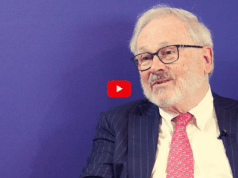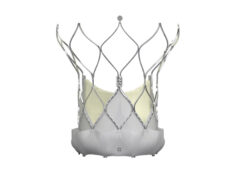
Long-term results of the UK TAVI trial, a pragmatic trial comparing transcatheter aortic valve implantation (TAVI) to surgical aortic valve replacement (SAVR) point to comparable rates of mortality, myocardial infarction (MI), endocarditis and reintervention between the two strategies at five years, but a higher incidence of stroke among TAVI patients.
“Most of the previously published major TAVI trials have focused on specific valves and were explanatory rather than pragmatic in their design,” said William Toff (University of Leicester, Leicester, UK), the study’s lead investigator, during a late-breaking trial session at the 2025 EuroPCR congress (20–23 May, Paris, France), where he reported the five-year findings of the study, which set out to compare the clinical effectiveness and cost utility of the two approaches.
Patients enrolled in the trial—which took place at TAVI centres across the UK—had severe, symptomatic aortic stenosis, were aged at least 70 years (with a median age of 81 years), and due to comorbidities or advanced age, were thought to be at increased operative risk.
“The trial had deliberately broad inclusion criteria and permitted the inclusion of patients with bicuspid valves, and those needing revascularisation,” said Toff. Unlike many of the industry-funded TAVI trials, UK TAVI permitted the use of any CE-marked TAVI valve, with no predefined risk score threshold for inclusion. Toff commented that the Society of Thoracic Surgeons (STS) risk score among the trial’s 913 participants stood at a median of 2.6, making it more akin to a low-risk trial.
One-year results of the trial, published in the Journal of the American Medical Association (JAMA) in 2022, demonstrated the non-inferiority of TAVI to SAVR for all-cause mortality, which was the primary endpoint. TAVI patients had a shorter hospital stay and fewer bleeding events, although significantly more vascular complications and conduction disturbances requiring pacemaker implantation did occur among these patients.
At five years, Toff reported at EuroPCR 2025 that there were no differences in all-cause deaths or those attributable to cardiovascular causes, but did note that there was an excess of strokes in the TAVI arm, which he said was not a “procedural phenomenon”, with the curves having begun to diverge at around four months, and continuing to do so through to five years. Around half of these strokes were disabling.
Quality of life metrics showed an early advantage for TAVI which persisted out to one year, although from two years onwards, there was no significant difference between the two strategies.
“UK TAVI is the first large pragmatic trial comparing a TAVI strategy with a surgical strategy to report five-year outcomes,” said Toff. “The findings are consistent with those of the explanatory trials, showing a similar treatment effect in respect of mortality, reintervention, endocarditis and MI, but we did identify an increased incidence of stroke after TAVI that clearly requires further elucidation.”
Commenting on the trial’s results during discussion that followed the presentation at EuroPCR, Michael Borger (Leipzig Heart Center, Leipzig, Germany) praised the research as providing an important addition to the results garnered from industry sponsored TAVI trials, which comprise the majority of the long-term data accumulated to date.
“I am a cardiac surgeon but I don’t belong to the group of surgeons that think that all industry sponsored trials are inherently evil—I see them as very, very useful. However, I readily acknowledge that industry will not sponsor a trial unless they think there is a reasonable chance that they will get a new indication or an indication expansion. That is why it is very important that we have these industry independent studies confirming what we see in industry studies.”
Borger also praised the broad inclusion criteria of the trial, and the device agnostic approach chosen by the investigators.
“The results you very clearly stated with a higher pacemaker rate than what we have seen in the modern low-risk industry sponsored trials, and also the higher stroke rate at five years, which is a novel finding,” he added, asking if there were any protocols in the trial concerning anticoagulation. Toff responded that there was no prespecified management strategy in UK TAVI, noting that there was a slightly higher use of anticoagulation in the surgery group, which may have been a contributor to the difference in stroke rates.
Ole De Backer (Rigshospitalet, Copenhagen, Denmark) asked Toff if any further investigation has been initiated to understand the late difference in stroke rates, whether there is any class effect between TAVI platforms, or whether leaflet thickening may be a factor.
“We will certainly be doing multivariable analysis to tease out what might underly the difference in stroke, but we haven’t done that quite yet,” said Toff, adding that in relation to leaflet thickening no echocardiography was performed after one year as investigators sought to emulate standard clinical practice.











